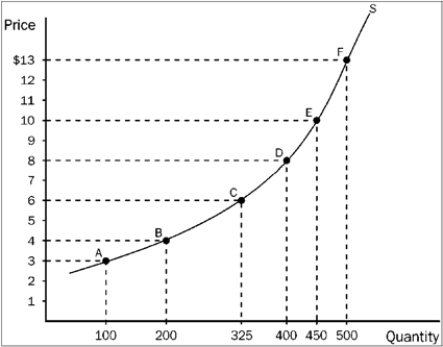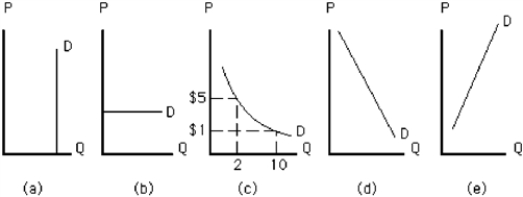A) highly elastic.
B) approximately equal to −0.33.
C) approximately equal to −3.
D) of unitary elasticity.
F) A) and C)
Correct Answer

verified
Correct Answer
verified
Multiple Choice
William likes Dr. Pepper and pork sandwiches. When the price of pork sandwiches rises, the substitution effect causes Dr. Pepper to be relatively
A) more expensive, so William buys more Dr. Pepper.
B) more expensive, so William buys less Dr. Pepper.
C) less expensive, so William buys more Dr. Pepper.
D) less expensive, so William buys less Dr. Pepper.
F) A) and C)
Correct Answer

verified
Correct Answer
verified
Multiple Choice
Which of the following is fully tax deductible (it is either subtracted or excluded from taxable income) under the current tax system of the United States?
A) Out-of-pocket medical expenses.
B) Healthcare insurance purchased through one's employer.
C) Healthcare insurance purchased directly by an individual or family.
D) All of the above.
F) C) and D)
Correct Answer

verified
Correct Answer
verified
Multiple Choice
As the Medicare program is expanded to cover the cost of prescription drugs for the elderly, other things constant, this will lead to
A) an increase in demand and higher prices for prescription drugs.
B) an increase in demand and lower prices for prescription drugs.
C) reduction in demand and lower prices for prescription drugs.
D) reduction in demand and higher prices for prescription drugs.
F) B) and C)
Correct Answer

verified
Correct Answer
verified
Multiple Choice
Which of the following would increase the incentive of consumers to economize and of producers to provide medical services at economical prices?
A) Substitution of catastrophic health insurance plans for low deductible, low co-payment plans.
B) More reliance on medical savings accounts rather than insurance.
C) Equalization of tax treatment between out-of-pocket medical expenses and employer-provided health insurance.
D) All of the above.
F) All of the above
Correct Answer

verified
Correct Answer
verified
Multiple Choice
Economic theory indicates that as a larger share of medical services are paid for by a third party (for example, insurance companies or the government) rather than directly by the consumer,
A) consumers will have a stronger incentive to economize.
B) consumers will have a weaker incentive to economize and the prices of medical services will rise more rapidly than would otherwise be the case.
C) consumers will have a weaker incentive to economize, but medical service suppliers will have a stronger incentive to keep prices low.
D) the suppliers of medical services will have more incentive to economize.
F) B) and C)
Correct Answer

verified
Correct Answer
verified
Multiple Choice
Figure 7-15  -Refer to Figure 7-15. Along which of these segments of the supply curve is supply least elastic?
-Refer to Figure 7-15. Along which of these segments of the supply curve is supply least elastic?
A) between E and F
B) between C and D
C) between A and C
D) between A and B
F) B) and D)
Correct Answer

verified
Correct Answer
verified
Multiple Choice
Which of the following would be the best example of consumer surplus?
A) Shaniqua does not get cell-phone service because she feels that it is worth less than the $30 a month fee.
B) Nicolas pays $8 for a haircut that is worth $10 to him.
C) Diego buys a house for $104,000, the maximum amount that he would be willing to pay for it.
D) Isabella purchases a book for $20 and uses a credit card to pay for it.
F) All of the above
Correct Answer

verified
Correct Answer
verified
Multiple Choice
From the standpoint of economic efficiency, which of the following is a major advantage of medical savings accounts?
A) They encourage healthcare consumers to purchase low-deductible, low co-payment medical insurance plans.
B) They guarantee that no American will ever have to pay another medical bill.
C) They encourage healthcare consumers to economize.
D) They will force employers to pay a larger share of the medical expenses of their employees.
F) B) and C)
Correct Answer

verified
Correct Answer
verified
Multiple Choice
Figure 7-16  -Which of the demand curves in Figure 7-16 is unit elastic?
-Which of the demand curves in Figure 7-16 is unit elastic?
A) the curve in graph a
B) the curve in graph b
C) the curve in graph c
D) the curve in graph d
E) the curve in graph e
G) None of the above
Correct Answer

verified
Correct Answer
verified
Multiple Choice
If the price of gloves increases, total expenditures on gloves will decline if
A) the demand for gloves is inelastic.
B) the demand for gloves is elastic.
C) the quantity of gloves purchased is unresponsive to changes in price.
D) there are few good substitutes for gloves.
F) A) and C)
Correct Answer

verified
Correct Answer
verified
Multiple Choice
Suppose an increase in the price of hair dryers leads to an increase in total expenditures on the hair dryers. Which of the following is true for this price change?
A) Hair dryers are an inferior good.
B) The demand for hair dryers is perfectly elastic.
C) The demand for hair dryers is inelastic.
D) The demand for hair dryers is elastic.
F) B) and D)
Correct Answer

verified
Correct Answer
verified
Multiple Choice
Suppose the Pleasant Corporation cuts the price of its American Girl dolls by 10 percent, and as a result, the quantity of the dolls sold increases by 25 percent. This indicates that the price elasticity of demand for the dolls over this range is
A) 2.5.
B) 0.4.
C) 0.5.
D) 5.
E) inelastic.
G) A) and D)
Correct Answer

verified
Correct Answer
verified
Multiple Choice
If the quantity demanded increases by 20 percent in response to a 10 percent decrease in price, demand is classified as
A) unstable.
B) relatively inelastic.
C) relatively elastic.
D) of unitary elasticity.
F) C) and D)
Correct Answer

verified
Correct Answer
verified
Multiple Choice
The price elasticity of demand for gasoline measures the
A) responsiveness of gasoline producers to changes in the quality of gasoline.
B) responsiveness of customers to changes in the price of gasoline.
C) responsiveness of consumer preferences to changes in the quality of gasoline.
D) both a and c above.
F) B) and C)
Correct Answer

verified
Correct Answer
verified
Multiple Choice
Have market forces failed in keeping healthcare costs under control?
A) Yes; in most high-income countries healthcare is a socialized industry and costs have been kept low.
B) Yes; the government has allowed market forces to determine costs, yet healthcare spending continues to rise rapidly.
C) No; government regulations have undermined the operation of markets and created perverse incentives that have led to rising prices and soaring healthcare expenditures.
D) No; market forces have been allowed to determine costs and those costs have remained low relative to the consumer price index.
F) A) and B)
Correct Answer

verified
Correct Answer
verified
Multiple Choice
If the board of regents of a major state university system plans to raise tuition in order to increase revenues, the regents must believe student demand is
A) elastic.
B) inelastic.
C) of unitary elasticity.
D) perfectly elastic.
F) B) and C)
Correct Answer

verified
Correct Answer
verified
Multiple Choice
The price elasticity of demand for a commodity is determined primarily by the
A) size of the consumer surplus.
B) attractiveness of the substitutes for the good.
C) incomes of consumers.
D) availability of complementary goods.
F) A) and C)
Correct Answer

verified
Correct Answer
verified
Multiple Choice
Other things equal, the demand for a good tends to be more inelastic when
A) there are fewer available substitutes.
B) a longer time period is considered.
C) the good is considered a luxury good.
D) the market for the good is more narrowly defined.
F) A) and D)
Correct Answer

verified
Correct Answer
verified
Multiple Choice
Marginal utility is the change in
A) total utility when an extra unit of output is produced.
B) total utility when an extra unit of output is consumed.
C) marginal utility when an extra unit of output is produced.
D) average utility when an extra unit of output is consumed.
F) C) and D)
Correct Answer

verified
Correct Answer
verified
Showing 161 - 180 of 229
Related Exams